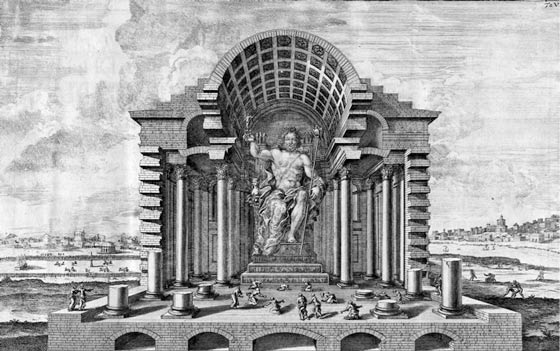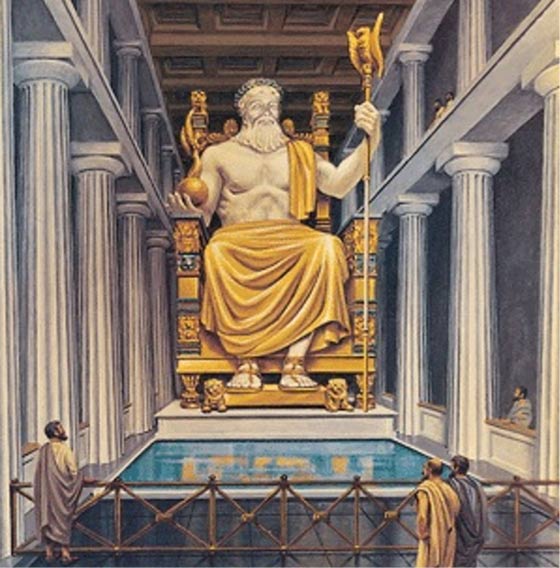By Jocelyn Hitchcock, Contributing Writer, Classical Wisdom
What do we really know?
It sounds like something straight out of the Hollywood machine that produced movies like Cleopatra and 300– and in all honesty, it kind of looks like a Hollywood prop piece too. The Statue of Zeus at Olympia has been deemed (rightly so) one of the seven wonders of the ancient world. It stood almost 40 feet high and was outfitted with gold, ivory, precious stones, and sat on a cedar wood throne. In one hand, the statue holds a scepter with an eagle perched on top; the other hand, a statue of Nike. It was placed inside the preexisting Temple of Zeus, which has quite the foundation myth itself. Conjured up in our minds is a statue with the force of nature behind it, inspiring awe and fear simultaneously.
Thousands of years later, we have fragments of the temple, including the pediments, the base of the steps and some columns, but the overall superstructure was ravaged by fire and earthquakes, leaving us with less than ideal remains. Unfortunately, the statue no longer exists entirely, as it was likely destroyed in Constantinople sometime after 426 AD, leaving us with a major gap in the material record that we would love to have filled. Who wouldn’t want to find a gigantic Greek god in all his glory poking out of the ground somewhere? However, this is not more than unlikely, it’s quite impossible.

Statue of Zeus
The Temple of Zeus at Olympia
When talking about the imposing Statue of Zeus at Olympia, you can’t do so without talking about the temple within which it was placed. After all, context is the key to understanding, right? The temple of Zeus was built around 470-456 BCE and was one of the largest on mainland Greece. It was built primarily of local limestone, but Parian marble decorations adorned the facade in Severe and Early Classical style. Later, when restoration and renovation was needed, Pentelic marble was used. The temple provides us with sculptures on the metopes and the West and East Pediments that are truly amazing. The metopes boast the 12 labors of Heracles, while the West Pediment shows the Battle of Lapiths and Centaurs at the wedding of Peirithos. The East Pediment illustrates preparations for the chariot race between Oinomaos of Pisa and Pelops for the hand of Hippodamia in marriage.
The overall impression we get of these depictions is that this is a temple honoring no small feats of strength, power, and man. No, this temple of Zeus reached for the highest caliber of laurels. Fittingly, the statue of Zeus that was commissioned to be placed inside the already existing temple was not to be any ordinary shrine. The statue of Zeus had to be more monumental than the accomplishments and stories of the heroes shown on the outside, making it clear the Zeus was trumping it all.

East Pediments
So how do we know about the statue in the first place? For this, we look to the many authors of Greece and Rome who committed the statue to writing. Strabo said that if the statue stood up, it would have lifted the roof of the temple. Pausanius also provides us with a detailed account of the statue and temple, describing Zeus to be ornamented with olive sprays, robes, intricate carvings, gold and ivory. Perhaps one of the more moving descriptions of the statue comes from Dio, who wrote that “a single glimpse of the statue would make a man forget all his earthly troubles.” It is safe to say that while this statue surpasses our idea of monumental and maybe even toes the line of ostentatious. Clearly, it impacted the very psyche of the visitors and patrons of the temple.
The statue took upwards of eight years to complete, and a workshop was built specifically for Pheidias to build it. Interestingly, we still have remains of what we think is Pheidias’ workshop. Thanks to the extensive literary descriptions we have of the statue, many reconstructions exist. While we can’t ever be sure that they are 100% accurate, it is certainly a great way to get an idea of just how massive and incredible this statue was. Take a look for yourself below and maybe you’ll be inspired to train for the Olympics in honor of this massive god:












No comments
Trackbacks
Our apologies, you must be logged in to post a comment.